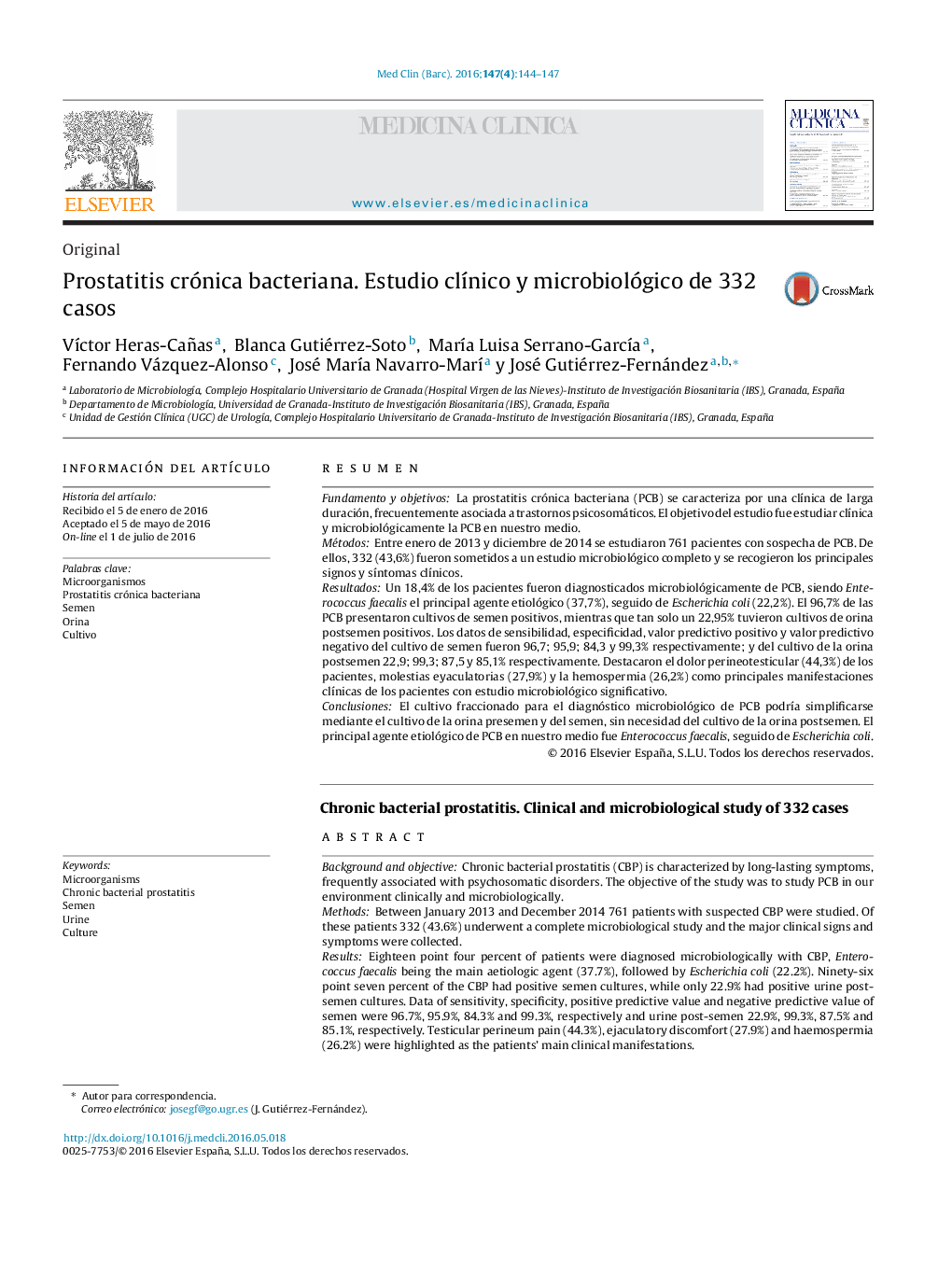| کد مقاله | کد نشریه | سال انتشار | مقاله انگلیسی | نسخه تمام متن |
|---|---|---|---|---|
| 3798959 | 1244495 | 2016 | 4 صفحه PDF | دانلود رایگان |
ResumenFundamento y objetivosLa prostatitis crónica bacteriana (PCB) se caracteriza por una clínica de larga duración, frecuentemente asociada a trastornos psicosomáticos. El objetivo del estudio fue estudiar clínica y microbiológicamente la PCB en nuestro medio.MétodosEntre enero de 2013 y diciembre de 2014 se estudiaron 761 pacientes con sospecha de PCB. De ellos, 332 (43,6%) fueron sometidos a un estudio microbiológico completo y se recogieron los principales signos y síntomas clínicos.ResultadosUn 18,4% de los pacientes fueron diagnosticados microbiológicamente de PCB, siendo Enterococcus faecalis el principal agente etiológico (37,7%), seguido de Escherichia coli (22,2%). El 96,7% de las PCB presentaron cultivos de semen positivos, mientras que tan solo un 22,95% tuvieron cultivos de orina postsemen positivos. Los datos de sensibilidad, especificidad, valor predictivo positivo y valor predictivo negativo del cultivo de semen fueron 96,7; 95,9; 84,3 y 99,3% respectivamente; y del cultivo de la orina postsemen 22,9; 99,3; 87,5 y 85,1% respectivamente. Destacaron el dolor perineotesticular (44,3%) de los pacientes, molestias eyaculatorias (27,9%) y la hemospermia (26,2%) como principales manifestaciones clínicas de los pacientes con estudio microbiológico significativo.ConclusionesEl cultivo fraccionado para el diagnóstico microbiológico de PCB podría simplificarse mediante el cultivo de la orina presemen y del semen, sin necesidad del cultivo de la orina postsemen. El principal agente etiológico de PCB en nuestro medio fue Enterococcus faecalis, seguido de Escherichia coli.
Background and objectiveChronic bacterial prostatitis (CBP) is characterized by long-lasting symptoms, frequently associated with psychosomatic disorders. The objective of the study was to study PCB in our environment clinically and microbiologically.MethodsBetween January 2013 and December 2014 761 patients with suspected CBP were studied. Of these patients 332 (43.6%) underwent a complete microbiological study and the major clinical signs and symptoms were collected.ResultsEighteen point four percent of patients were diagnosed microbiologically with CBP, Enterococcus faecalis being the main aetiologic agent (37.7%), followed by Escherichia coli (22.2%). Ninety-six point seven percent of the CBP had positive semen cultures, while only 22.9% had positive urine post-semen cultures. Data of sensitivity, specificity, positive predictive value and negative predictive value of semen were 96.7%, 95.9%, 84.3% and 99.3%, respectively and urine post-semen 22.9%, 99.3%, 87.5% and 85.1%, respectively. Testicular perineum pain (44.3%), ejaculatory discomfort (27.9%) and haemospermia (26.2%) were highlighted as the patients’ main clinical manifestations.ConclusionsFractionated culture for the microbiological diagnosis of CBP could be simplified by the culture of urine pre-semen and semen, without the need for the culture of urine post-semen. The main aetiologic agent of CBP in our media was Enterococcus faecalis, followed by Escherichia coli.
Journal: Medicina Clínica - Volume 147, Issue 4, 19 August 2016, Pages 144–147
